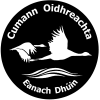Evelyn Stevens talks to Dutch thatcher Marika Leen about the art of thatching and how she came to learn the trade. Filmed in Cloonboo, Annaghdown, Co. Galway in summer 2020, at the thatched cottage of Pete Smith and Evelyn Stevens. An initiative of the Annaghdown Heritage Society. Labhraíonn Evelyn Stevens leis an tuídóir Ollainnis, Marika Leen, faoi chéird na tuíodóireachta agus an bealach a d’fhoghlaim sí an céird. Taifeadta i gCluain Bú, Eanach Dhúin, Co. na Gaillimhe, i samhradh 2020, ag teach ceann tuí Pete Smith agus Evelyn Stevens. Tionscnamh de chuid Cumann Oidhreachta Eanach Dhúin.
Video: Thatching in Cloonboo, with Marika Leen








